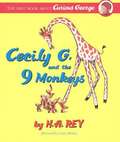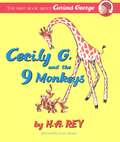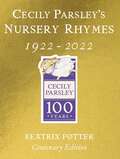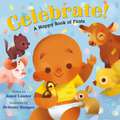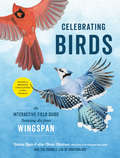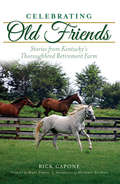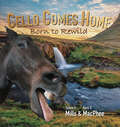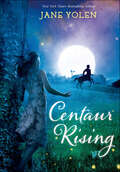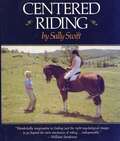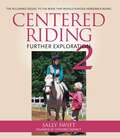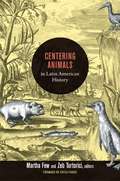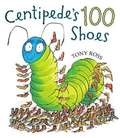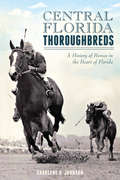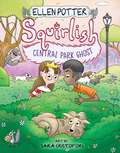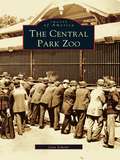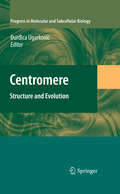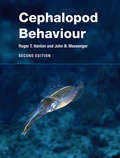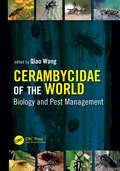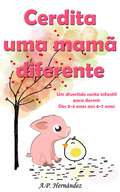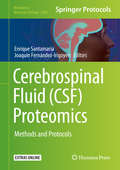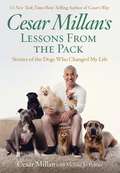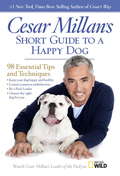- Table View
- List View
Cecily G. and the 9 Monkeys
by H. A. ReyWith afterword by Louise Borden Now in paperback: The first story to feature Curious George, with a historical afterword by Louise Borden. “There is originality and a childlike humor in both the amusing antics and engaging pictures. ”—Booklist A lonely giraffe with no playmates meets nine monkeys with no home. Can there be a happy ending? Of course there can—one of the monkeys is Curious George! This is the first story to feature Curious George, and when you read it, you’ll know why children demanded that Margret and H. A. Rey give him his very own adventures. Enjoy the fun on every page of this playful celebration of imagination and friendship. Louise Borden, author of The Journey that Saved Curious George, has written an afterword placing Cecily G. in historical context vis-a-vis the development of Curious George and the Reys’ personal journey.
Cecily G. and the Nine Monkeys
by H. A. Rey Margret ReyA lonely giraffe with no playmates and nine monkeys with no home team up for adventure. Curious George is among the nine little monkeys playing with Cecily G.
Cecily Parsley's Nursery Rhymes (Beatrix Potter Originals)
by Beatrix PotterCelebrate 100 years of Cecily Parsley's Nursery Rhymes!Discover this timeless gold edition of Cecily Parsley's Nursery Rhymes on the 100th anniversary of its first publication. Full of delightful rhymes, such as Goosey Goosey Gander, This Little Piggy and Three Blind Mice, each one carefully reimagined in Potter's traditional style. Packed with Beatrix Potter's original watercolour illustrations and classic rhymes, Cecily Parsley's Nursery Rhymes has delighted young readers for generations. The ideal gift for fans of Peter Rabbit and Beatrix Potter. Other titles in this series include:Beatrix Potter: The Complete TalesThe World of Peter Rabbit: The Complete CollectionPeter Rabbit: The Complete Adventures
Celebrate!: A Happy Book of Firsts
by Janet LawlerOur first words, our first steps, these and so much more are things we celebrate!But when a bird flaps its wings for the first time, or a kitten makes its first climb—do they also celebrate?Celebrate! is a sweet and joyous rhyming picture book about life’s milestones, how we celebrate, and wondering what else we might accomplish in our lives as we grow!
Celebrating Birds: An Interactive Field Guide Featuring Art from Wingspan
by Natalia Rojas Ana Maria MartinezA gorgeously illustrated and interactive full-color guide to more than 181 birds of North America, based on the bestselling board game, Wingspan.Praised for its gorgeous illustrations, accurate portrayal of bird habitats, and its gameplay, the bird-focused board game Wingspan has become an international sensation, available in a dozen languages and selling more than 200,000 copies its first year. Celebrating Birds is the ultimate companion to the game for fans, as well as a beautiful and in-depth field guide for avian and nature enthusiasts.In addition to large-size representations of each bird and the most up-to-date bird descriptions provided by Cornell Lab of Ornithology, Celebrating Birds includes a step-by-step guide that can be used to take the game into the real world. Players can collect points based on the birds, nests, and various habitat and feeding clues they find outside.Artists and best friends Natalia Rojas and Ana Maria Martinez collaborated to create the beautiful depictions featured in the original Wingspan board game. Celebrating Birds features larger illustrations of the 170 North American birds from the game, plus eleven exciting new birds.With Celebrating Birds, players and amateur naturalists can discover details about many of the birds currently at risk for extinction. As the number of birds in the United States and Canada has declined precipitously, Celebrating Birds is a fun way to raise awareness, educate, encourage activism, and provide resources on some of the most important ecological issues facing us today.
Celebrating Old Friends: Stories from Kentucky’s Thoroughbred Retirement Farm
by Rick Capone Mary Simon Michael BlowenWhen Michael Blowen first dreamed of creating Old Friends, he envisioned a place where Thoroughbred stallions could retire with dignity following their racing or breeding careers. He also wanted people to visit the iconic horses. In 2003, Old Friends opened on leased land with a miniature horse named Little Silver Charm, a gelding named Invigorate and a mare named Narrow Escape. Today, the two-hundred-plus-acre farm in Georgetown has more than 160 retired Thoroughbred stallions, geldings and mares, including two Kentucky Derby winners. It even welcomed two satellite farms, one in New York and one at Kentucky Downs racetrack. In his follow-up to History of Old Friends, Rick Capone revisits the unforgettable history of this horse retirement home.
Cello Comes Home: Born to Rewild
by Simon Mills Ross MacPheeJoin celebrated children's author, Simon Mills and Dr. Ross MacPhee, Senior Curator, Department of Mammalogy, Division of Vertebrate ZoologyProfessor Emeritus, Richard Gilder Graduate School, American Museum of Natural History on a rewilding adventure that opens eyes and hearts. This true story follows the horse's journey over ten thousand years to a modern-day stallion named Cello who leads us to explore the science of rewilding planet Earth.
Cells in Evolutionary Biology: Translating Genotypes into Phenotypes - Past, Present, Future (Evolutionary Cell Biology)
by Brian K. Hall Sally A. MoodyThis book is the first in a projected series on Evolutionary Cell Biology, the intent of which is to demonstrate the essential role of cellular mechanisms in transforming the genotype into the phenotype by transforming gene activity into evolutionary change in morphology. This book —Cells in Evolutionary Biology — evaluates the evolution of cells themselves and the role cells have been viewed to play as agents of change at other levels of biological organization. Chapters explore Darwin’s use of cells in his theory of evolution and how Weismann’s theory of the separation of germ plasm from body cells brought cells to center stage in understanding how acquired changes to cells within generations are not passed on to future generations. The study of evolution through the analysis of cell lineages during embryonic development dominated evolutionary cell biology until usurped by the switch to genes as the agents of heredity in the first decades of the 20th century. Discovery that cells exchanged organelles via symbiosis led to a fundamental reevaluation of prokaryotic and eukaryotic cells and to a reorganizations of the Tree of Life. Identification of cellular signaling centers, of mechanisms responsible for cellular patterning, and of cell behavior and cellular condensations as mediating the plasticity that enables phenotypic change during evolution, provided powerful new synergies between cell biology and evolutionary theory and the basis for Evolutionary Cell Biology. Key Selling Features: Summarizes the long history of the essential role of cells in evolutionary change. Demonstrates that cellular processes transform genetic change into phenotypic change in development and in evolution. Documents the evidence that cells provide the missing mechanistic link between the genotype and the phenotype in evolutionary theory. Illustrates the necessity of integrating cell biology into evolutionary theory.
Centaur Rising
by Jane YolenOne night during the Perseid meteor shower, Arianne thinks she sees a shooting star land in the fields surrounding her family's horse farm. About a year later, one of their horses gives birth to a baby centaur. The family has enough attention already as Arianne's six-year-old brother was born with birth defects caused by an experimental drug—the last thing they need is more scrutiny. But their clients soon start growing suspicious. Just how long is it possible to keep a secret? And what will happen if the world finds out?At a time when so many novels are set in other worlds, Jane Yolen imagines what it would be like if a creature from another world came to ours in this thoughtfully written, imaginative novel, Centaur Rising.A Christy Ottaviano Book
Centered Riding
by Sally SwiftCentered Riding is for those with little experience all the way up to world class. Precise illustrations and photographs never before used in riding books explain anatomy and image work to give mind and body new and relaxed approaches to the inner process of riding. Widely known for her innovative teaching philosophy stressing body awareness, the value of "soft eyes," proper breathing, centering, and balance, Sally Swift has been a pioneering riding instructor for half a century. In book form for the first time, her methods enable horse and rider to achieve harmony, working together naturally, without pain. Unlike traditional teachers, Sally Swift does not believe in forced training techniques that cause stiff bodies and tense riding. Instead, through the use of vivid, unusual, and highly creative images that transcend mechanics ("Pretend you're a spruce tree; the roots grow down from your center as the trunk grows up"), plus a thorough knowledge of human and equine anatomy, this wise and inspiring teacher enables the conscientious equestrian to reassess habitual responses, in order to ride in natural positions, break through frustrating plateaus, and achieve ever-rising goals with comfort, vitality, and precision.
Centered Riding 2
by Sally SwiftCentered Riding is not a style of riding as are dressage, hunter seat, or Western. Rather, it is a way of reeducating a rider&’s mind and body to achieve greater balance in order to better communicate with the horse. Founder Sally Swift revolutionized riding by showing that good use of the human body makes a world of difference on horseback. Early in her work, she established what she calls the &“Four Basics&” — centering, breathing, soft eyes, and building blocks—which, together with grounding, are the main tenets of her method. When a rider learns and maintains these basics, then harmony between horse and human is possible. Sally Swift&’s first book, Centered Riding, made its revolutionary appearance in 1985 and continues as one of the best-selling horse books of all time. This second book doesn't replace the first one, it complements it. In the intervening years, Centered Riding continued to evolve, and Sally inevitably developed many new concepts and fresh imagery, all of which are presented here.
Centering Animals in Latin American History
by Martha Few Tortorici ZebCentering Animals in Latin American History writes animals back into the history of colonial and postcolonial Latin America. This collection reveals how interactions between humans and other animals have significantly shaped narratives of Latin American histories and cultures. The contributors work through the methodological implications of centering animals within historical narratives, seeking to include nonhuman animals as social actors in the histories of Mexico, Guatemala, the Dominican Republic, Puerto Rico, Cuba, Chile, Brazil, Peru, and Argentina. The essays discuss topics ranging from canine baptisms, weddings, and funerals in Bourbon Mexico to imported monkeys used in medical experimentation in Puerto Rico. Some contributors examine the role of animals in colonization efforts. Others explore the relationship between animals, medicine, and health. Finally, essays on the postcolonial period focus on the politics of hunting, the commodification of animals and animal parts, the protection of animals and the environment, and political symbolism. Contributors. Neel Ahuja, Lauren Derby, Regina Horta Duarte, Martha Few, Erica Fudge, León García Garagarza, Reinaldo Funes Monzote, Heather L. McCrea, John Soluri, Zeb Tortorici, Adam Warren, Neil L. Whitehead
Centipede's One Hundred Shoes
by Tony RossHave fun with numbers in this hilarious new picture book by master storyteller and illustrator Tony Ross. "One hundred shoes, please!" said the little centipede. "Fifty left ones, and fifty right ones." "Why do you want one hundred?" asked the shoe seller. "Because I'm a centipede, which means a hundred feet," said the little centipede. But when are one hundred shoes too many shoes? And what do you do with too many shoes? Why, you give them away! Find out who gets them in this delightfully silly story about a centipede with sore feet.
Central Florida Thoroughbreds: A History of Horses in the Heart of Florida (Sports)
by Charlene R. JohnsonBack in the 1940s, when Florida was the Wild West of the East, a few hearty souls dared to think they might compete with the finest, blue-blooded racehorses and their breeders with their own stock raised among palm trees, sand and alligators. Florida was the cracker cowboy state, and cowponies were expected. But the scoffers failed to realize what the wealth of limestone, the power of warm sunshine year round and the cold, crystalline freshwater springs that are the gems of central Florida would mean to the raising of healthy, competitive animals. When the first Thoroughbreds produced in Florida, admittedly small and scrappy, began to "outrun their pedigrees," the nation of Thoroughbred breeders had to take notice. Join author Charlene R. Johnson as she details the fascinating equine history of central Florida.
Central Park Ghost (Squirlish #3)
by Ellen PotterCordelia and Isaac set out to solve a monstrous mystery at the Central Park Zoo in this exciting third installment of the &“sweet and silly&” (Booklist) Squirlish series perfect for fans of Sophie Mouse and Critter Club!Cordelia is a human girl raised by squirrels in Central Park and well-known among the park&’s other critters. When she gets an urgent message summoning her to the Central Park Zoo, Cordelia learns from the sea lions that a monster has been roaming the park grounds—something the size of a bear with glowing eyes! With the help of her best friend, Isaac, Cordelia sets out to trap this mystery creature. They follow a string of questionable leads taking them to a dog park, a parade, and even an encounter with the New York Yankees! But can they find the Central Park Ghost?
Central Park Zoo, The
by Joan ScheierCountless New Yorkers, as well as visitors from all parts of the world, have experienced an oasis just a few feet off Fifth Avenue in the heart of Manhattan. Since the 1860s, Central Park has been the home of three different zoos: the menagerie, the zoo of 1934, and what is today known as the Central Park Zoo. The Central Park Zoo begins with the menagerie of the 1860s, an impromptu public zoo begun when citizens and circuses started donating animals to the city. It continues in 1934, when Robert Moses-perhaps the most influential man in the city's planning history-built a newer zoo, remembered to this day for its lions, tigers, elephants, and gorillas. It ends with the brand new zoo and exhibits built in 1988 under the supervision of the Wildlife Conservation Society. With stunning, rarely seen images, The Central Park Zoo not only is a treat for the eyes but also comes alive with the barking of sea lions, the soft fur of snow monkeys, the sweet smell of peanut butter, and the taste of "ice cakes"-treats for the zoo residents, of course.
Centromere: Structure and Evolution (Progress in Molecular and Subcellular Biology #48)
by Durdica UgarkovicThe centromere is a chromosomal locus that regulates the proper pairing and segregation of the chromosomes during cell division. Despite their conserved, essential function, centromeres are characterized by the rapid evolution of both centromeric DNA and proteins. This book presents current views on centromere structure and identity. It deals with the epigenetic concept of centromere establishment and maintenance as well as with the role of DNA and centromeric transcripts in centromere formation and function. Special emphasis is placed on centromere evolution: different evolutionary models are discussed in detail and the latest research on the evolution of new centromeres and neocentromeres is presented.
Cephalopod Behaviour (2nd Edition)
by Roger T. Hanlon John B. MessengerWith their large brains, elaborate sense organs and complex behaviour, cephalopods are among the world’s most highly evolved invertebrates. This second edition summarises the wealth of exciting new research data stemming from over 500 papers published since the first volume appeared. It adopts a comparative approach to causation, function, development and evolution as it explores cephalopod behaviour in natural habitats and the laboratory. Extensive colour and black-and-white photography illustrates various aspects of cephalopod behaviour to complement the scientific analysis. Covering the major octopus, squid and cuttlefish species as well as the shelled Nautilus, this is an essential resource for undergraduate and advanced students of animal behaviour, as well as researchers new to cephalopods, in fields such as neuroscience and conservation biology. By highlighting the gaps in current knowledge, the text looks to inform and to stimulate further study of these beautiful animals.
Cephalopod Cognition
by Anne-Sophie Darmaillacq Ludovic Dickel Jennifer Mather Anne-Sophie Darmaillacq Ludovic DickelCephalopods are generally regarded as the most intelligent group among the invertebrates. Despite their popularity, relatively little is known about the range and function of their cognitive abilities. This book fills that gap, accentuating the varied and fascinating aspects of cognition across the group. Starting with the brain, learning and memory, Part I looks at early learning, memory acquisition and cognitive development in modern cephalopods. An analysis of the chambered nautilus, a living fossil, is included, providing insight into the evolution of behavioural complexity. Part II surveys environmental responses, especially within the active and learning-dependent coleoids. The ever-intriguing camouflage abilities of octopus and cuttlefish are highlighted, alongside bioluminescence, navigation and other aspects of visual and cognitive competence. Covering the range of cognitive function, this text underscores the importance of the cephalopods within the field of comparative cognition generally. It will be highly valuable for researchers, graduates and senior undergraduate students.
Cerambycidae of the World: Biology and Pest Management (Contemporary Topics in Entomology)
by Qiao WangWang has gathered contributions from an impressive cohort of the world’s most respected experts on longhorned beetles. Chapters review both basics of cerambycid taxonomy, mor- phology, and behavior (feeding, reproduction, and chemical ecology), as well as more applied concerns, such as laboratory rearing, pest control, and bio- security. Overall, this volume is a valuable contribution to the literature as a "one-stop shop" for readers seeking a comprehensive overview of longhorned beetles... It represents a tremendous effort on the part of Wang and the authors, and has resulted in a much-needed update to the literature. This volume is the only work of its kind available at this time, and is a valuable addition to the library of any scientist studying wood-boring beetles. - Ann M. Ray, Biology, Xavier University, Cincinnati, Ohio in The Quarterly Review of Biology, Volume 94, 2019 There are more than 36,000 described species in the family Cerambycidae in the world. With the significant increase of international trade in the recent decades, many cerambycid species have become major plant pests outside their natural distribution range, causing serious environmental problems at great cost. Cerambycid pests of field, vine, and tree crops and of forest and urban trees cost billions of dollars in production losses, damage to landscapes, and management expenditures worldwide. Cerambycidae of the World: Biology and Pest Management is the first comprehensive text dealing with all aspects of cerambycid beetles in a global context. It presents our current knowledge on the biology, classification, ecology, plant disease transmission, and biological, cultural, and chemical control tactics including biosecurity measures from across the world. Written by a team of global experts, this book provides an entrance to the scientific literature on Cerambycidae for scientists in research institutions, primary industries, and universities, and will serve as an essential reference for agricultural and quarantine professionals in governmental departments throughout the world.
Cerdita uma mamã diferente (dos 3-4 anos aos 6-7 anos): Um divertido conto infantil para dormir (dos 3-4 anos aos 6-7 anos)
by Antonio Costa A. HernándezAo acordar, Cerdi encontra um ovo. O ovo, aparecera do nada, misteriosamente. De quem é? Como é que chegou ali? Estará alguém à sua procura? Cerdi, que quer ser mãe de todo o coração, quer ficar com ele e incubá-lo-la com amor e carinho, mas Juan, seu amigo burro, convence-a de que primeiro ela precisa encontrar a sua mãe. Assim, Cerdi e seu fiel conselheiro Juan, empreendem uma viagem pela quinta para desvendar os mistérios em torno desse ovo. Esta história foi concebida para abordar, de maneira lúdica e didática, valores como responsabilidade, compromisso, honestidade, generosidade e amor. Um livro infantil ágil que se torna numa ferramenta para pais, professores de Educação Infantil e Ensino Primária, pedagogos e psicólogo para o ensinamento de valores.
Cerebrospinal Fluid: Methods and Protocols (Methods in Molecular Biology #2044)
by Enrique Santamaría Joaquín Fernández-IrigoyenThis volume focuses on protein analysis, including a wide range of the use of mass spectrometry and other protein methods within neurobiological disciplines. Chapters cover topics such as cerebrospinal fluid (CSF) processing and biobanking; label-free quantitative proteomics; SWATH; top-down proteomics; and experimental strategies based on other –omics applied to CSF metabolome, lipidome, and microRNAome. Written in the highly successful Methods in Molecular Biology series format, chapters include introductions to their respective topics, lists of the necessary materials and reagents, step-by-step, readily reproducible laboratory protocols, and tips on troubleshooting and avoiding known pitfalls.Cutting-edge and thorough, Cerebrospinal Fluid (CSF) Proteomics: Methods and Protocols is a valuable resource for graduate students and post-doctoral fellows interested in learning more about CSF proteotyping. It is also useful to established researchers seeking further insight into this growing field.
Cesar Millan's Lessons From the Pack: Stories of the Dogs Who Changed My Life
by Cesar Millan Melissa Jo PeltierIn this inspiring book, best-selling author and "Dog Whisperer" Cesar Millan uses decades of experience to reveal the many ways that dogs and people can enrich each other's lives, sharing eight essential life lessons imparted by a group of very special dogs he's trained over the years. From his roster of celebrity clients to his reality television series, Cesar Millan is America's most sought-after dog behavior expert. Now, he reveals the amazing ways that our pets can teach us. In this affecting book, he shares eight heartwarming stories about the dogs that have inspired him the most—and the lessons he's learned from them about healing and more. Each chapter, drawing on celebrity and noncelebrity clients alike, spotlights the essential traits that allow these animals to make the best of their situations—from authenticity to acceptance—and reveals how we can embrace these values to enrich our own lives. Sharing never-before-told insights, Cesar imparts a unique blueprint for seeking happiness and fulfillment through canine companionship.
Cesar Millan's Lessons from the Pack
by Cesar MillanFrom his roster of celebrity clients to his reality television series, Cesar Millan is America's most sought-after dog behaviour expert. Now, he reveals the amazing ways our pets can teach us. In this affecting book, he shares eight heartwarming stories about the dogs that have inspired him the most - and the lessones he's learned from them about healing and more. Each chapter, drawing on celebrity and noncelebrity clients alike, spotlights the essential traits that allow these animals to make the best of their situations - from authenticity to acceptance - and reveals how we can embrace these values to enrich our own lives. Sharing never-before-told insights, Cesar imparts a unique blueprint for seeking happiness and fulfillment through caninc companionship.
Cesar Millan's Short Guide to a Happy Dog
by Cesar MillanAfter more than 9 seasons as TV's Dog Whisperer, Cesar Millan has a new mission: to use his unique insights about dog psychology to create stronger, happier relationships between humans and their canine companions.Both inspirational and practical, A Short Guide to a Happy Dog draws on thousands of training encounters around the world to present 98 essential lessons. Taken together, they will help any owner apply the key aspects of Cesar's celebrated philosophy to create the most fulfilling life possible with their dogs.In these pages, Cesar delves into crucial themes that go beyond obedience-school basics to reveal the hearts and minds of our beloved pets. In short, practical takes, he explores:* The basics of dog psychology* Instinctual behaviors* Creating balance and boundaries* Managing common misbehaviors* Choosing the right dog for your family* Helping your dog adjust to life transitionsThroughout the book, inspiring stories from Cesar's case files -- and from his new TV show, Leader of the Pack - provide moving real-world applications and surprising life lessons.Smart, easy to use, and packed with Cesar's remarkable insights into human and canine behavior, A Short Guide to A Happy Dog is an inspiring tool for anyone looking to live a better life with a beloved member of the family.
